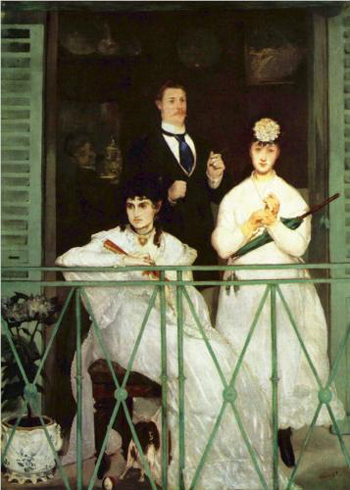| Search Art Prints | ||||||||||||||||||||
| Search Artists | ||||||||||||||||||||

|
||||||||||||||||||||
|
|
|||||||||||||||||||

The Balconyalso known as Le balcon

|
The Balcony
In approximately 1868, French artist Édouard Manet abruptly set aside the trendy subject of bourgeois life, a common scenic theme at the time, and created ‘The Balcony’, also known under its original French title ‘Le balcon’.
The painting depicts four figures, all of whom are believed to have been close friends of Édouard Manet. The obscure boy in the dark background is considered to be Manet’s (step) son Leon Leenhoff. The elegant man standing behind the two women in white attire is the painter Antoine Guillemet, while the woman to his right, holding an umbrella for shade and fiddling with her gloves, is the young violinist Fanny Claus. Most importantly, perhaps, is the seated lady, Berthe Morisot, who soon became a favorite model for Manet after posing for ‘The Balcony’. It is considerably noticeable that the gaze of all four subjects is set in a different direction. They appear not only detached from one another, but also isolated in thought and void of emotional expression, thereby creating a setting that lacks a narrative.
Although the artist was likely inspired by Francisco Goya’s “The Majas at the Balcony”, the impassive atmosphere of this particular piece shows evidence that Monet was attempting to fracture his scholarly restrictions.
The Balcony’s Public Reception
When the painting was presented at the 1869 Salon, the response consisted largely of confusion and misunderstanding. It was regarded as provocative in nature due to the bold use of vivid colors against a dark, almost disconcerting background, which, for many, was perceived to render a brutal contrast. The caricaturist Cham stated with a note of sarcasm, “Close the shutters!” Another critic attacked Manet with the following harsh words: “[Manet] lowered himself to the point of being in competition with the painters of the building trade.”
Today many artists and critics consider Édouard Manet to be the forefather of modern art, and that a painting such as ‘The Balcony’, which consists of realism and defiance against conventional and traditional techniques, was far too shocking for a public that clearly was not ready for revolutionized art.
About the Artist
Much to the dismay of his strongly politically-connected parents, Édouard Manet showed a keen interest in painting very early in life. At the age of sixteen, his father Auguste Manet urged him to sail on a training vessel to Rio de Janeiro, most likely to deter his son’s passion; however, after Édouard failed the exam to join the Navy twice, his father relented and allowed him to pursue artistic instruction. During his spare time from his studies under Thomas Couture, Manet visited the Louvre and copied the old masters of fine art. In 1856, he opened an art studio, which was the beginning of his somewhat notorious painting career.
When his father passed away in 1862, Manet married Suzanne Leenhoff with whom he had been romantically involved for the previous ten years. Originally, she was hired by Auguste as a piano teacher for his two children, and was possibly Auguste’s mistress as well. In 1852, Suzanne gave birth to a son whom she named Leon Koella Leenhoff – who has been deemed to be either Auguste or Édouard’s son.
“The Balcony” or “Le balcon” is currently located at the Musee d'Orsay in Paris, France.











